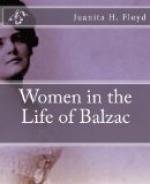Since Balzac was attracted to beautiful names as well as to beautiful women, that of the Duchesse d’Abrantes appealed to him, independently of the wealth of history it recalled. He was happy to make the acquaintance of one who could give him precise information of the details of the Directoire and of the Empire, an instruction begun by the commere Gay. Thus the Duchesse d’Abrantes was to exercise over him, though in a less degree, the same influence for the comprehension of the Imperial world that Madame de Berry did for the Royalist world, just as the Duchesse de Castries later was to initiate him into the society of the Faubourg Saint-Germain.
Madame d’Abrantes, pleased as she was to meet literary people, welcomed most cordially the young author who came to her seeking stories of the Corsican. Owing to financial difficulties she was leading a rather retired and melancholy life, and the brilliant and colorful language of Balzac, fifteen years her junior, aroused her heart from its torpor, and her friendship for him took a peculiar tinge of sentiment which she allowed to increase. It had been many years since she had been thus moved, and this new feeling, which came to her as she saw the twilight of her days approaching, was for her a love that meant youth and life itself.
Hence her words pierced the very soul of Balzac and kindled an enthusiasm which made her appear to him greater than she really was; she literally dazzled and subjugated him. Her gaiety and animation in relating incidents of the Imperial court, and her autumnal sunshine, its rays still glowing with warmth as well as brightness, compelled Balzac to perceive for the second time in his life the insatiability of the woman who has passed her first youth—the woman of thirty, or the tender woman of forty. The fact is, however, not that Balzac created la femme sensible de guarante ans, as is stated by Philarete Chasles, so much as that two women of forty, Madame de Berny and Madame d’Abrantes, created him.
This affection savored of vanity in both; she was proud that at her years she could inspire love in a man so much younger than herself, while Balzac, whose affection was more of the head than of the heart, was flattered—it must be confessed—in having made the conquest of a duchess. Concealing her wrinkles and troubles under an adorable smile, no woman was better adapted than she to understand “the man who bathed in a marble tub, had no chairs on which to sit or to seat his friends, and who built at Meudon a very beautiful house without a flight of stairs."[*]
[*] This house, Les Jardies, was at Ville-d’Avray and not at Meudon.
But the love on Balzac’s side must have been rather fleeting, for many years later, on March 17, 1850, he wrote to his old friend, Madame Carraud, announcing his marriage with Madame Hanska: “Three days ago I married the only woman I have ever loved.” Evidently he had forgotten, among others, the poor Duchess, who had passed away twelve years before.




